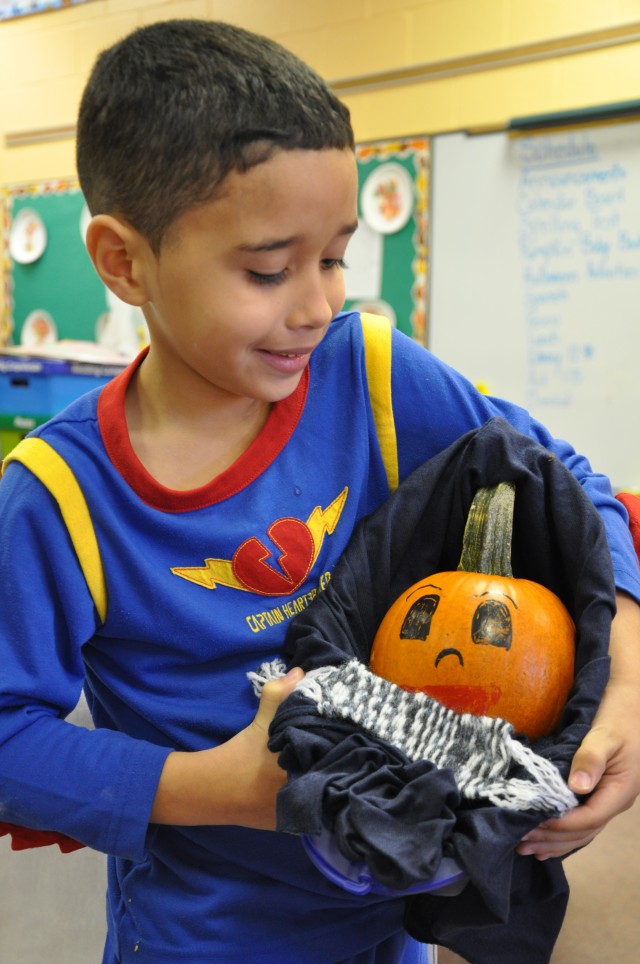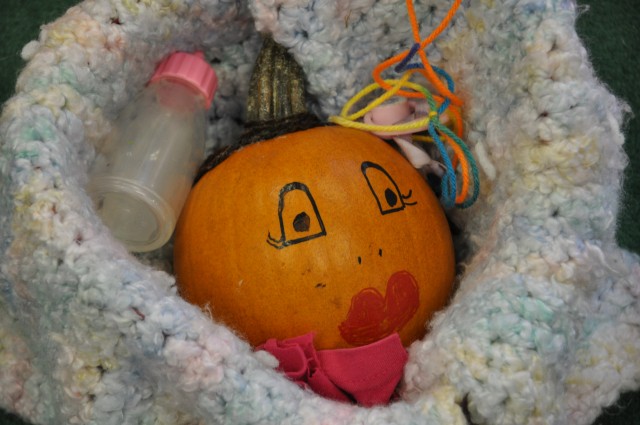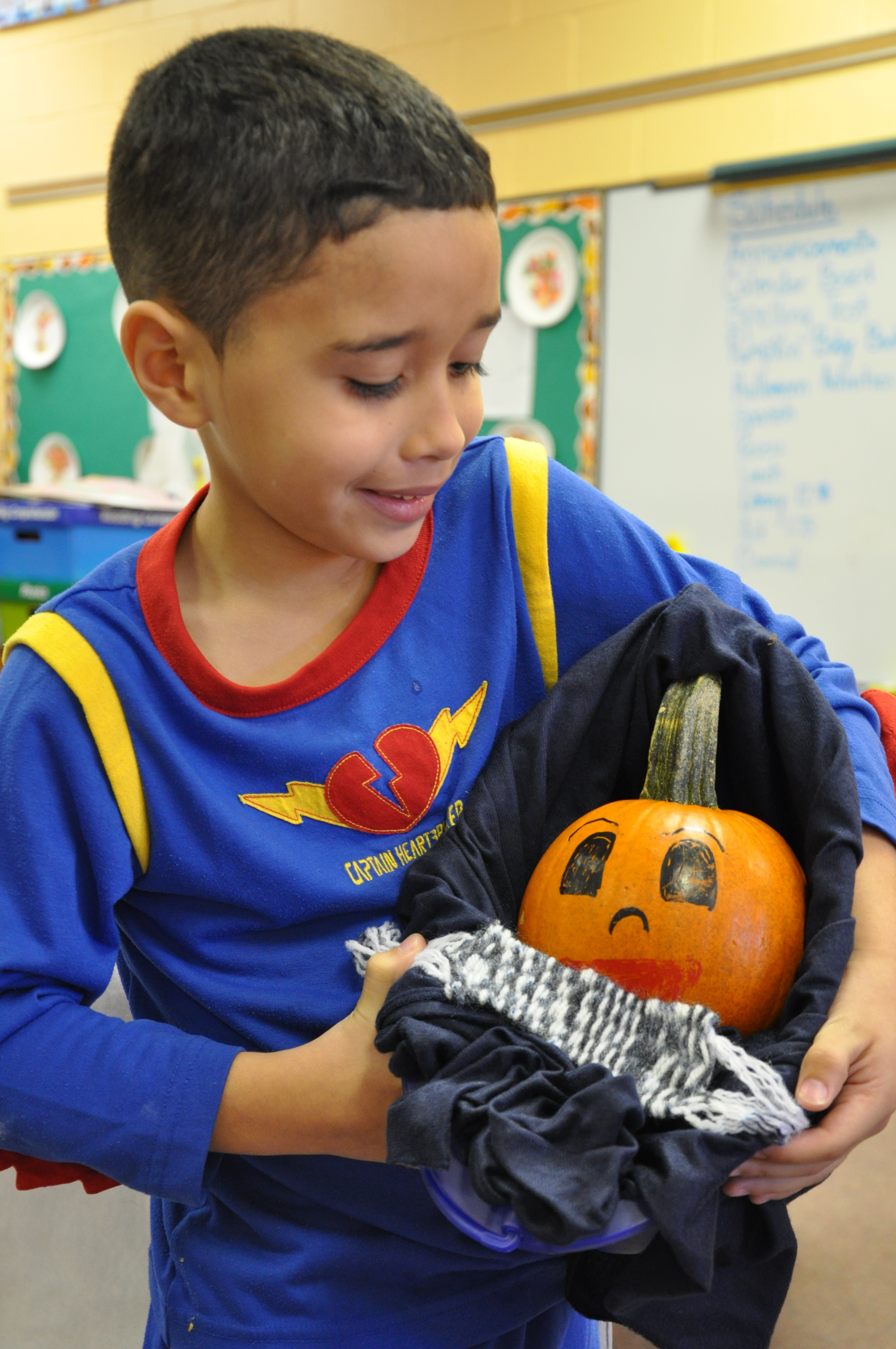FORT JACKSON, S.C. -- As many children learned the art of pumpkin carving last week, some Fort Jackson children were taught to be responsible pumpkin caretakers.
In the days leading up to Halloween, and as more and more jack-o-lanterns landed on doorsteps, "pumpkin babies" were born to the second graders at Pierce Terrace Elementary School.
During a weeklong project designed to teach the intricacies of parenting, the students were required to shelter their pumpkins, clothe and feed them, read and sing to them, and more.
"It's just a great opportunity to see what it's like to be a parent and have a little bit of appreciation for some of the things they do," said Nancy Kerr, one of three Pierce Terrace second grade teachers.
For more than 20 years, Fort Jackson second graders have participated in the pumpkin babies project, which provides a fall theme for the students to incorporate and improve upon many of their skills, including reading, writing and solving math problems, Kerr said.
On the first day of the project, the students went to a makeshift "delivery room" where they were each delivered a pumpkin baby. The new parents chose the sex of their babies, named, weighed and measured them, and filled out birth certificates. That night, they decorated their pumpkin babies' faces, dressed them and provided bedding for them.
Some children transported their pumpkin babies to school the next day in doll-size strollers, baskets or bassinets.
They took photos of and with their babies to put in baby books, in which the students were required to document their babies' progress as they grew from infants to toddlers to school-age children.
The students recorded their babies' measurements and milestones, including their first smiles and when they began to walk. They made up math word problems about their pumpkins, wrote essays about what kind of parents they would like to be, and generated questions to ask their babies' teachers during a mock parent-teacher conference.
The students also wrote letters to their own parents - the pumpkin babies' grandparents - telling them how much their babies had grown, what they were doing, and how special they are. One child wrote to his parents that they would be so proud of the father he had become.
The novice parents learned safety rules for toddlers, such as plugging covers in electrical outlets, turning pot handles in, and not letting babies sit on the stove.
The students were required to keep their pumpkin babies supervised at all times. The children rotated as babysitters during lunch and recess. Many of the new moms and dads took their pumpkin babies on shopping trips and to sports practices, while others were resourceful in finding babysitters at home.
Angela Ward, whose daughter Camryn is a student in Wanda Beatty's second grade class, said by the end of the week, Camryn was paying sitters candy bars to watch her baby while she went on outings.
But during the first couple of days, she often had to remind Camryn that raising the pumpkin baby was her responsibility.
"When we went to the store ... she asked me if she could leave her baby in the car," Ward said. "I asked her, 'Would you want me to leave you in the car' No, you have to take your baby in the store with us.'"
While shopping, Camryn left the pumpkin baby on the carts gathered in the front of the store.
"When she came near me I said, 'Oh, so you're just going to leave your baby unattended' You can't do that. You're going to get in trouble,'" Ward said. "Then she took it very seriously. I think she learned a lot, most importantly the responsibility of keeping up with somebody other than herself."
And that was the main objective of the project, said second grade teacher Amy Henderson - to give the students "an increased sense of responsibility and what it's really like to have to keep up with a child 24 hours a day."
For some students, keeping the babies in the forefront of their minds was a difficult task.
"A couple of students forgot their babies in places and they had to run back and get them," Henderson said. "We had a couple (pumpkin babies) who took tumbles off the tops of bunk beds."
For others, the excitement of being a new parent was all they could think about.
"We had one (pumpkin baby) who was banished to the closet to sleep in for the night because the student wouldn't go to sleep because he was playing with the pumpkin baby," Henderson said. "The student's dad had to put the pumpkin baby in the closet so the little boy could go to sleep."
And for a few select students who had twins, they experienced the pressures of having to do double the work.
"In real life, having twins means twice the money, twice the responsibility," Henderson said. "In this project, it means twice the work, twice the baby books."
But for most of the students, nurturing pumpkin babies for a week allowed them to grow academically and socially.
"And hopefully, it gave them a better appreciation of mom and dad and all the things they do," Kerr said.




Social Sharing